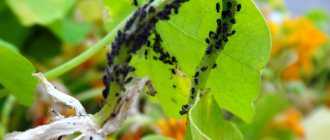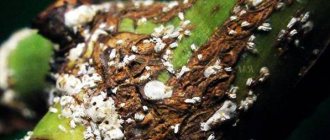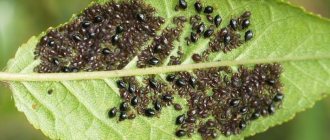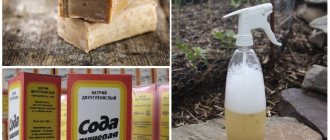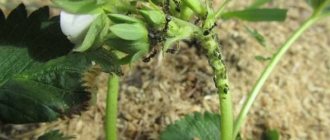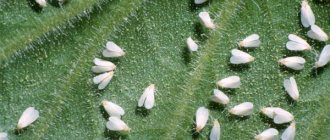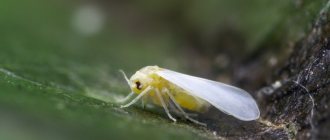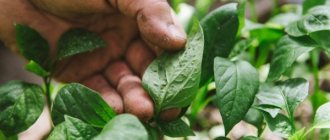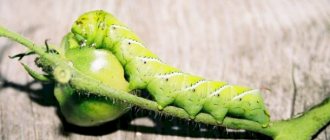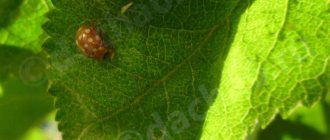A greenhouse is a great way to taste aromatic cucumbers, tomatoes, and peppers in early spring. Complex open-ground crops, such as eggplants, are planted there. Aphids in a greenhouse become a real disaster. In a confined space, plants simply don't stand a chance. You need to be prepared for this and know how to get rid of aphids and how to deal with them correctly.
Danger of aphids
Most often, cucumbers, plums and other melons are susceptible to attack by this parasite, since aphids are attracted to the juice secreted by the young plant. In addition, the pest is capable of releasing poison that harms the shoots, since it causes them to die, making it almost impossible to restore the damaged crop. Aphids are also carriers of many viruses that can poison not only the plant, but also the soil. If you do not resort to any methods of combating aphids, then in one month of summer this parasite can cause significant damage to the garden, which is quite difficult to restore.
Reasons for appearance
Aphids can enter a greenhouse in several ways. Sometimes even the precautions taken do not save. You need to start fighting it immediately upon first detection, since many remedies cannot have an immediate result, and the insect will continue to destroy the crop for several more days.
Routes of entry:
- During ventilation of the greenhouse, small pests can fly inside and remain.
- Aphids can be found in organic fertilizers, so when fertilizing the soil in the greenhouse, the pest also penetrates into a new habitat.
- The insect waits out the winter inside the buds of the plant. When planting cuttings, they must be processed. Otherwise, in the spring there will be a lot of small insects in the greenhouse.
- Sometimes the pest enters the greenhouse when soil is added. It can also be infected.
Aphids in a greenhouse
Of the many types of aphids, only a few can live in a greenhouse:
- potato;
- melon or cotton;
- large potato;
- greenhouse or tobacco.
The speed at which aphids spread is amazing. Therefore, the longer measures to destroy it are absent, the greater the harm will be caused.
Basic rules for controlling aphids
- First you need to find out why the aphid decided to ruin the rich harvest of cucumbers. It should be remembered that multi-season plants are too much for her, but young shoots are her favorite delicacy. So, the gardener needs to protect the newly planted plants;
- As for the reasons for its appearance, there can be many of them, but mainly it is carried by ants that feed on aphids;
- There is no universal method of combating aphids, since their colony is numerous and each affects a particular plant. Therefore, several methods should be used.
How to treat a greenhouse in the fall against diseases and pests. Greenhouse treatment in autumn
Greenhouses for vegetables are empty and “dirty”, with a full range of pests and plant diseases, depleted soil, spilled with small plant debris. Vegetables can suffer from various diseases due to sharp changes in day and night temperatures, dense planting, excess soil and air moisture, as well as overfeeding with nitrogen fertilizers.
If you do not treat the greenhouse in the fall, in the hope that the frost will disinfect the greenhouses, then already at the beginning of summer the plants planted here will be damaged by pests and diseases.
- Cucumbers and peppers will suffer from mites, aphids, downy mildew, bacterial diseases and root rot;
- tomatoes - from spotting, from the same aphids.
- And everyone together will suffer from the whitefly, which has an unprecedented harvest this year.
Preparing the greenhouse for processing
- Carefully remove all plant debris.
- Wash the inside of the structures and glass/polycarbonate with at least plain water. You can spray the structures with a fungicide.
- If possible, remove the top layer of soil, which contains the maximum amount of infection.
- If it is not possible to replace the top layer, then make punctures with a shovel at a distance of 10-15 cm from each other to the depth of the shovel bayonet.
- To prevent diseases, you should first collect and remove all plant debris from the greenhouse.
- They should be burned or buried deeper.
- Then dig up the soil using a spade and remove all the weed rhizomes.
There is no need to break up and level the lumps of earth - in this form, many pest larvae will die in them from winter frosts and more weed seeds will freeze out.
Next, fertilizers should be added to the soil per 1 m²:
- 20 – 25 g of potassium fertilizer,
- 30 – 40 g superphosphate,
- 4 – 6 kg of humus.
— For a greenhouse with a film coating:
- The film is removed from the greenhouse and, if it is not too damaged, used in the next season: to do this, it must be dried, rolled up and stored indoors.
- Treatment of the greenhouse structure in the fall consists of disinfecting the wooden posts with a 10% solution of copper sulfate.
- Metal parts and wires should be wiped with a rag moistened with kerosene.
- The greenhouse can also be treated in this way: spray with a solution of bleach (400 g per bucket of water, leave for a couple of hours, and then strain).
— If the greenhouse is made of polycarbonate or glazed:
- in the fall, its structure and glass from the inside can be disinfected with a 2% formaldehyde solution (1 liter of solution per 1 m²).
Ways to combat aphids
Soap spraying
Spraying the plant with a soap solution is a simple method of controlling aphids and is suitable for cleaning all plants. The greatest harm to aphids comes from ash (ash from wood), which has a cleansing and antibacterial effect, and this parasite really doesn’t like cleanliness.
Required ingredients:
- water – 10 l.;
- laundry soap – 200 gr.;
- tar soap – 100 gr.;
- ash – 100 gr.
Preparation:
- Soap (laundry and tar) dissolves in water.
- Now all that remains is to boil the ash. A liter of water is placed on the burner and brought to a boil, ash is added and boiled for another 30 minutes.
- After the mixture has boiled, it must be poured into the soap solution and stirred.
The described recipe will allow you to get rid of aphids once and for all in just a few procedures. In order to spray the plants, the solution must be poured into 5 liters. eggplant and close it with a lid with a spray bottle.
Plant solution
Even though the disinfectant solution is not a chemical, it can cause serious harm to the plant and even become a threat to human health. Therefore, you need to use them wisely. Most often, gardeners use onion and potato solutions, since they are more gentle on the plant, but do not leave aphids a single chance.
Onion solution
Required ingredients:
- onions – 30 g;
- water – 1 l.;
- laundry soap – 5 gr.
Preparation:
- The onion head must be peeled and chopped.
- Next, the onion is filled with water and infused for 5 hours.
- Now you need to add soap and strain the entire solution.
For a more concentrated solution, you can add onion peels.
Potato solution
Required ingredients:
- potato tops – 1 kg;
- sulfur soap – 10 g;
- water – 10 l.
Preparation:
- The tops are crushed and infused in water for at least 3 hours.
- After the specified time, the solution is filtered.
- Then soap is added and the solution is infused for another hour, after which it will be ready for use.
It is necessary to carefully select potatoes and take only healthy tops.
Preventive measures
In the confined space of a greenhouse, it is worth carrying out comprehensive work to prevent the development of pests and diseases. After harvesting, it is necessary to disinfect the structure itself, tools and soil in the greenhouse.
Processing the greenhouse and equipment in the fall
Treatment of the greenhouse after harvesting consists of washing the structure and disinfecting it. Metal parts and windows can be washed with soapy water or bleach. Fumigation with a sulfur bomb is perfect for disinfection.
The procedure for treating a greenhouse in the fall with a saber is as follows:
- The first step is to ensure the integrity of the coating of the metal parts. If the enamel has chips or cracks, they must be primed and painted over. If this is not possible, cover with a thick layer of grease to prevent corrosion.
- It is necessary to make sure that all windows and doors close tightly, there are no cracks or holes, so that the gas does not evaporate in vain.
- A non-combustible base (brick, metal basin) is placed on the ground in the center of the greenhouse, and a checker is placed in it. The checker is set on fire.
- Next, you need to leave the greenhouse as quickly as possible, closing the door tightly.
Tilling the land in autumn
Soil treatment is carried out in several stages.
- All plant residues, wooden pegs, and strings are removed and burned so that pests do not hide in them for the winter.
- The earth is being dug up.
- Then the soil is disinfected. To do this, the ground can be watered with a solution of copper sulfate or Bordeaux mixture.
- If the design of the greenhouse allows, you can leave a window or door open for the winter. The soil will freeze, the pests and eggs that remain in it will die.
Advice! To further freeze the soil in the greenhouse in winter, you can throw a 20-30 cm layer of snow on the beds and leave it until spring. Melted snow will additionally moisten the soil with the arrival of warmth.
Emergency methods of control
If the aphid is taken by surprise, then you can overcome it using the following emergency methods:
- Russian ordinary vodka. You need to put a sprayer on a bottle of the cheapest vodka - and the product is ready! Vodka has an excellent effect on aphids as a disinfectant. But it is worth considering that alcohol can harm the plant, leaving burns on it;
- Coca Cola. As in the previous recipe, you need to put a spray bottle on the neck of Coca-Cola and spray the pests from it. Due to the fact that this drink contains orthophosphoric acid, this fact explains the harmful effect of Coca-Cola on aphids;
- milk and iodine. If you mix milk and iodine in equal proportions, you can get the No. 1 killer against aphids. Perhaps this method is the most gentle for a damaged plant.
How to fight with chemicals?
There are chemical, biological and traditional methods to destroy parasites. The latest generation of chemicals are highly effective and safe for plants. They are able to simultaneously destroy other pests and neutralize larvae. Advantages of the chemical method of killing aphids:
- To completely destroy harmful insects, it is enough to treat the plants 1-2 times;
- the effect of the drug begins immediately after treatment;
- Preparation of the drug is simple, described in the instructions;
- 3 weeks after processing, the fruits are edible.
Chemicals can be used in a greenhouse. A special climate is formed there, which is favorable for the spread of aphids - high humidity, high temperature.
The following drugs are recognized as effective.
- "Karbofos". Powerful insecticide against parasites. The solution is prepared at the rate of 1 large spoon of the drug per 10 liters of water. Application on seedlings allows you to destroy aphids and get a decent harvest of vegetables.
- “Fufanol” is a drug with a wide range of effects, it helps to remove aphids, mites, moths, whiteflies, and moths. Plants should be treated with the drug in dry weather. Prepare the solution according to the instructions - 5 ml (1 ampoule) per 1-2 liters of water.
- "Aktara" is a preparation for treatment in the early stages of plant development. Affected plants must be treated twice with an interval of 7 days. The chemical is effective against many pests. After 30 minutes, the insects refuse to eat and die within a day.
- “Intavir” is a remedy for numerous vegetable pests, produced in the form of tablets. They are dissolved in a bucket of water; this solution should be poured over the peppers. The drug creates a film that is poisonous to aphids on the surface of the stems and leaves of bell peppers.
- “Commander” is an excellent tool to save plants from larvae and adults. It is used in open ground, since the main substance is not washed off with water and does not lose its activity in direct sunlight.
- Iskra is a toxic product and must be diluted strictly according to the instructions. The drug can be used as a prophylaxis.
- "Tanrek" is a modern drug that can effectively remove aphids. Capable of accumulating in the soil and overcoming the tissue barrier of plants.
- Copper sulfate is a product in the form of blue granules. You need to make a paste from them, mix with water and a pink solution of potassium permanganate. Used to treat the soil around plants to prevent aphids from attacking them.
The majority of chemicals do not pose a threat to humans and domestic animals, which may accidentally eat treated plants or fruits
But when treating with insecticides, you must be careful and use personal protective equipment. Active substances in contact with mucous membranes can cause a chemical burn.
Birds and insects in the fight against aphids
To defeat aphids, you can use the help of our smaller brothers and thereby protect plants from being poisoned by chemicals.
Insects that eat aphids:
- hoverfly;
- ladybug;
- fly;
- lacewing;
- earwig;
- rider;
- ground beetle;
- wasps and bedbugs.
To lure a particular type of insect, a certain crop should be planted. For example, daisies attract ground beetles with their scent, and lacewings love ferns most of all. If there is no room to plant a new crop, then you can throw some wood shavings into a regular flower pot and the summer resident is guaranteed to have an earwig!
Birds that eat aphids (but this is more likely for an open area):
- sparrow;
- Chiffchaff Warbler;
- willow warbler;
- tit;
- king;
- wren;
- robin;
- linnet.
In order to attract these birds to their plots, gardeners make small feeders. You should also remember that if you resort to this method of treating your garden against parasites, you should forget about using various chemicals, as this may harm birds.
Prevention measures
It will be necessary to prevent the appearance of pests in the greenhouse. It applies to her.
Disinfection
Before planting plants on the site, it must be prepared. The interior space must be disinfected.
Material
Seed material is an important stage in preparing a greenhouse. It is selected correctly, inspected and disinfected. The same applies to seedlings.
Caution
Do not get carried away with watering, do not create high humidity. Remove weeds in a timely manner.
